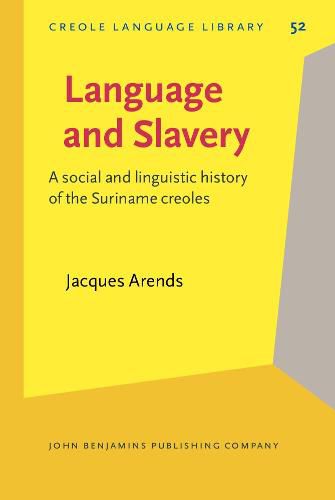Readings Newsletter
Become a Readings Member to make your shopping experience even easier.
Sign in or sign up for free!
You’re not far away from qualifying for FREE standard shipping within Australia
You’ve qualified for FREE standard shipping within Australia
The cart is loading…






This posthumous work by Jacques Arends offers new insights into the emergence of the creole languages of Suriname including Sranantongo or Suriname Plantation Creole, Ndyuka, and Saramaccan, and the sociohistorical context in which they developed. Drawing on a wealth of sources including little known historical texts, the author points out the relevance of European settlements prior to colonization by the English in 1651 and concludes that the formation of the Surinamese creoles goes back further than generally assumed. He provides an all-encompassing sociolinguistic overview of the colony up to the mid-19th century and shows how ethnicity, language attitude, religion and location had an effect on which languages were spoken by whom. The author discusses creole data gleaned from the earliest sources and interprets the attested variation. The book is completed by annotated textual data, both oral and written and representing different genres and stages of the Surinamese creoles. It will be of interest to linguists, historians, anthropologists, literary scholars and anyone interested in Suriname.
$9.00 standard shipping within Australia
FREE standard shipping within Australia for orders over $100.00
Express & International shipping calculated at checkout
This posthumous work by Jacques Arends offers new insights into the emergence of the creole languages of Suriname including Sranantongo or Suriname Plantation Creole, Ndyuka, and Saramaccan, and the sociohistorical context in which they developed. Drawing on a wealth of sources including little known historical texts, the author points out the relevance of European settlements prior to colonization by the English in 1651 and concludes that the formation of the Surinamese creoles goes back further than generally assumed. He provides an all-encompassing sociolinguistic overview of the colony up to the mid-19th century and shows how ethnicity, language attitude, religion and location had an effect on which languages were spoken by whom. The author discusses creole data gleaned from the earliest sources and interprets the attested variation. The book is completed by annotated textual data, both oral and written and representing different genres and stages of the Surinamese creoles. It will be of interest to linguists, historians, anthropologists, literary scholars and anyone interested in Suriname.